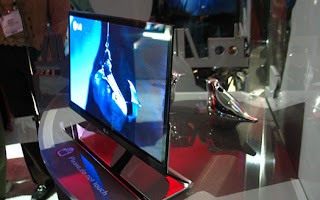Many people ask the question: "OLED vs AMOLED, what is the difference and which one is better?"
Well lets keep things simple...
OLED vs AMOLED
As mentioned before OLED is Organic Light Emitting Diode and involves a thin film of organic
material, which receives an electric charge to create light. AMOLED (Active Matrix Organic Light
Emitting Diode) involves an extra layer of material made up of an active matrix of OLED pixels. Each
individual pixel acts as a switch, regulating the flow of electric current.
To summarise, within an AMOLED display, each individual pixel is controlled and so this enables
higher resolutions to be achieved, resulting ultimately in larger screens, allowing AMOLED televions
to be made at the sizes we have come to expect of our tvs.
How do you make a larger screen OLED television? - AMOLED, thats how.
Size is Important
Size has always been an important factor, The first OLED tvs were very small screens, Sony's 11inch
model sold for around £2,000 whereas LG's 15 inch model was selling for around £2,500.
Now Samsung has developed 55inch OLEDs, currently Sony is also working on large OLED screens.
Super AMOLED
Taking size and cost of manufacturing into consideration, it makes sense that AMOLED technology is used in the manufacturing of cell phones and as we now see in the market place, this is becoming increasingly more familiar in cell phones, with Samsung leading the way.
Super AMOLED is the technology used in cell phones, it is primarily based on AMOLED but specifically integrates the touch sensitive layer into the screen, rather than being layered on top, as most touch screen phones are. As a result thinner mobile phones with brilliant resolutions can be made.
OLED and AMOLED in 2012- What is the status?
Can you believe that the first OLED tv screens emerged almost 4 years ago. As yet these type of televisions have not taken over our stores. The reason is simply down to the cost of manufacturing which still remains very expensive.
To be fair however, in the early days of OLED, most manufacturers estimated that their OLED tvs will hit the stores with full force in 2015 and it would seem that they are very much on target.
There are a few more years yet then for the manufacturing costs to dramatically
reduce.
Summary of OLED vs AMOLED
So as you can see, OLED vs AMOLED is not a battle between the two technologies as such, but instead
it is an evolution of the OLED technology.




We make the custom synthesis process more efficient and cost effective while maintaining the highest standards of quality and reliability. HAT-CN
ReplyDelete